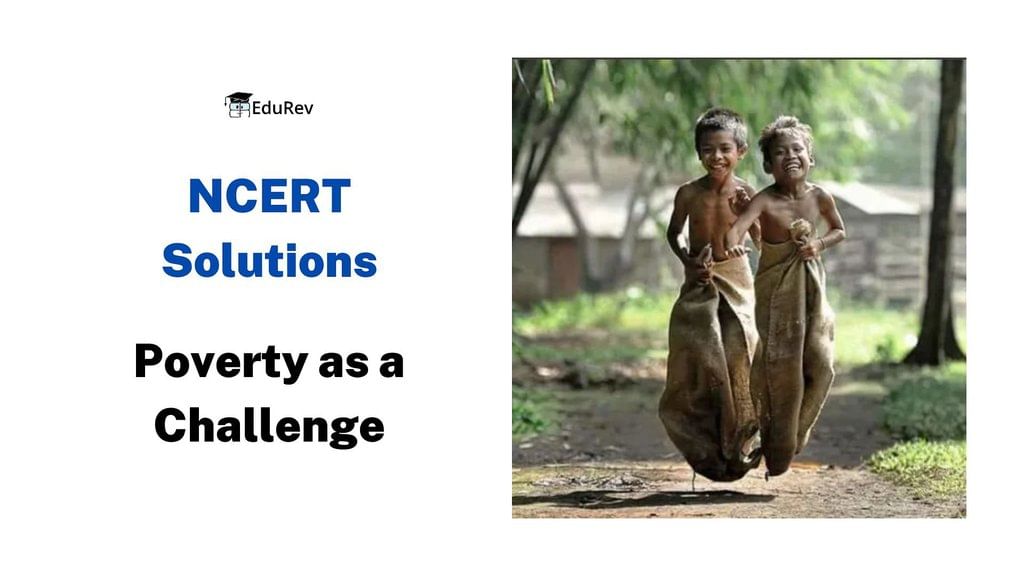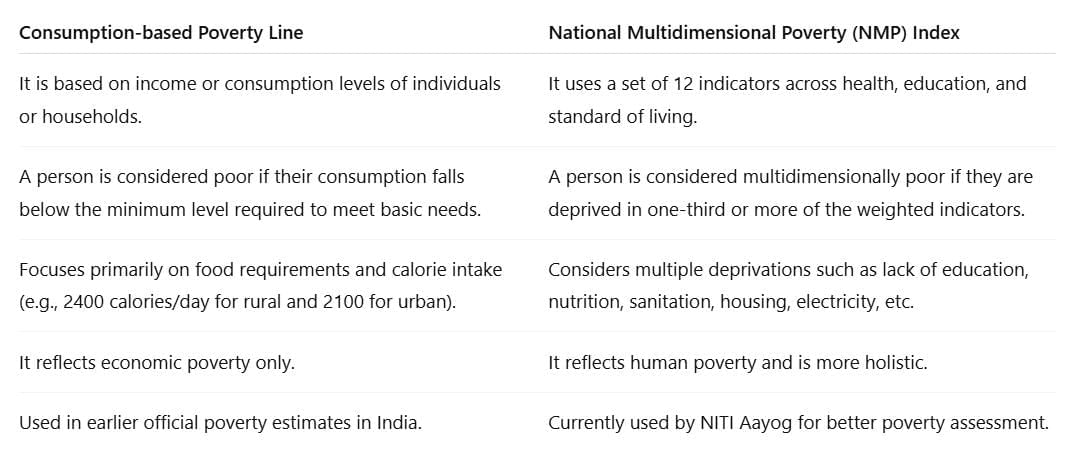NCERT Solutions for Class 9 Economics Chapter 3 - Poverty as a Challenge
 Q1. How is the poverty line estimated in India?
Q1. How is the poverty line estimated in India?
Ans: In India, the poverty line is estimated based on the income or consumption needed to meet basic needs like food, clothing, and shelter.
Calculating food requirements in calories:
- Rural areas: 2400 calories per person per day
- Urban areas: 2100 calories per person per day
The cost to meet these needs is determined and adjusted for inflation.
For 2011-12, the poverty line was set at:
- Rs 816 per person per month in rural areas
- Rs 1000 per person per month in urban areas
The poverty line is updated periodically based on large sample surveys conducted by the National Sample Survey Office (NSSO).
Q2. Do you think that the present methodology of poverty estimation is appropriate?
Ans: The current methodology for estimating poverty focuses mainly on minimum subsistence levels. A person is considered poor if their income or consumption is below a specific threshold needed to meet basic needs.
- This approach does not account for a reasonable standard of living.
- It primarily measures income or consumption levels.
- Different countries have varying definitions of what constitutes basic needs.
- For example, lacking a car may indicate poverty in the US, while in India, it is seen as a luxury.
Many experts argue that the definition of poverty should be broadened to include factors like:
- Education
- Healthcare
- Job security and self-confidence
- Freedom from discrimination
Overall, the current method may be too narrow and does not fully capture the complexities of poverty.
Q3. Describe poverty trends in India since 1973?
Ans: Overall decline in poverty: Since 1973, India has seen a significant drop in poverty levels:
- Poverty fell from approximately 55% in 1973 to 36% in 1993, and further to 22% in 2011-12.
- All states have experienced a decline in poverty since the early 1970s, although the rate of reduction varies.
- As of the Multidimensional Poverty Index 2019-21, the national poverty rate is 15%.
- States such as Kerala, Gujarat, Punjab, and Jammu and Kashmir have shown notable improvements.
Despite the overall decline, disparities exist among states. For instance:
- States like Karnataka, Tamil Nadu, and Delhi had a headcount ratio below 10% in 2019-21.
- States such as Bihar and Uttar Pradesh have made significant progress.
In summary, while poverty has decreased in India, the pace and extent of this reduction vary across different regions.
Q4. Discuss the major reasons for poverty in India?

Ans: Major reasons for poverty in India:
- Colonial Rule: India went through a long phase of low economic development under the British colonial administration. The policies of the colonial government ruined traditional handicrafts and discouraged the development of industries like textiles.
- Low economic growth and high population growth: The Indian administration’s failure on the two fronts − promotion of economic growth and population control perpetuated the cycle of poverty.
- Rural Poverty: The effects of agricultural and rural development were limited to only certain parts of the country. The presence of huge income inequalities is a major reason for the high poverty rates in rural areas.
- Urban Poverty: The jobs created by the industrial sector haven't been enough for everyone looking for work. Because they can't find good jobs in cities, many people end up working as rickshaw pullers, vendors, construction workers, or domestic servants.
Q5. Identify the social and economic groups which are most vulnerable to poverty in India.
Ans: The social groups most vulnerable to poverty in India include:
- Scheduled Castes households
- Scheduled Tribes households
The economic groups at risk are:
- Rural agricultural labour households
- Urban casual labour households
Q6. Give an account of interstate disparities of poverty in India.
Ans: The proportion of poor people varies significantly across Indian states. Key points include:
- The average Head Count Ratio (HCR) in India was 22% in 2011-12.
- In 2019–21, Bihar, Jharkhand, and Uttar Pradesh had high multidimensional poverty ratios.
- In contrast, states such as Kerala, Maharashtra, and Tamil Nadu have seen significant reductions in poverty.
- These states have achieved this through a combination of agricultural growth and human capital development.
- States like Punjab and Haryana have also successfully reduced poverty, primarily through high agricultural growth rates.
Q7. Describe global poverty trends.
Ans: The success rate of reducing poverty varies significantly across different regions, leading to disparities in poverty levels.
- Odisha, Bihar, and Madhya Pradesh are the three poorest states, with poverty rates of 47%, 42%, and 37% respectively.
- Conversely, Jammu and Kashmir, Punjab, and Himachal Pradesh are among the states with the lowest poverty levels.
Globally, there has been a notable decline in poverty:
- China and South-East Asia, rapid economic growth and significant investments in human resources have led to a reduction in poverty.
- In Latin America, the poverty rate has remained relatively stable.
- In Sub-Saharan Africa, poverty declined slightly from 36.6% in 2017 to 35% in 2019.
- Poverty has also emerged in some former socialist countries, such as Russia, where it was previously negligible.
Q8. Describe the role of government in reducing poverty in India?
 MNREGA
MNREGA
- Prime Minister’s Rozgar Yojana (PMRY): Launched in 1993, this programme aims to create self-employment opportunities for educated unemployed youth in rural areas and small towns.
- Pradhan Mantri Gramodaya Yojana (PMGY): Initiated in 2000, it focuses on improving basic services such as primary health, education, rural housing, drinking water, and electrification.
- Rural Employment Generation Programme (REGP): Started in 1995, this programme aims to create self-employment opportunities in rural and urban areas.
- Mahatma Gandhi National Rural Employment Guarantee Act (MGNREGA): Enacted in September 2005, it guarantees 100 days of employment per year to every rural household in 200 districts, with plans to expand to 600 districts. One-third of the jobs are reserved for women.
Q9. What do you understand by human poverty?
Ans: Human poverty extends beyond mere lack of income. It encompasses the denial of essential political, social, and economic opportunities necessary for a decent standard of living.
- Illiteracy
- Lack of job opportunities
- Inadequate access to healthcare and sanitation
- Caste and gender discrimination
Q10: Who are the poorest of the poor?
Ans: The poorest of the poor are individuals or families who experience extreme deprivation. They often face multiple challenges, including:
- Severe income shortages, living on less than $2.15 a day.
- Lack of access to basic necessities such as food, clean water, and shelter.
- Limited access to education and healthcare, leading to poor health outcomes.
- High levels of indebtedness, making it difficult to escape poverty.
- Social exclusion and discrimination, which further marginalise them.
These factors create a cycle of poverty that is hard to break, trapping them in a state of helplessness and vulnerability.
Q11: What are the main features of the Mahatma Gandhi National Rural Employment Guarantee Act 2005?
Ans: The main features of the Mahatma Gandhi National Rural Employment Guarantee Act 2005 are:
- The Act guarantees 100 days of employment each year for every rural household.
- It reserves one-third of the jobs for women.
- The Act promotes sustainable development to combat issues like drought, deforestation, and soil erosion.
- Employment shares for Scheduled Castes (SCs), Scheduled Tribes (STs), and women are 23%, 17%, and 53% respectively.
- The wage rate for workers is regularly revised and has increased over the years.
- The scheme has provided 220 crore person-days of employment to 4.78 crore households.
Q12: Differentiate between consumption-based poverty line and NMP Index-based poverty estimates.
Ans: 
Q13: List the indicators used to estimate multidimensional poor in India.
Ans: The National Multidimensional Poverty Index (NMP Index) developed by NITI Aayog uses the following 12 indicators to assess multidimensional poverty in India:
- Nutrition: A household is deprived if any child (0-59 months), woman (15-49 years), or man (15-54 years) is undernourished.
- Child-Adolescent Mortality: A household is considered deprived if a child or adolescent under 18 has died within the last five years.
- Maternal Health: A household is deprived if any woman has given birth in the last five years without skilled medical assistance.
- Years of Schooling: A household is deprived if no member aged 10 or older has completed six years of schooling.
- School Attendance: A household is deprived if any school-aged child is not attending school.
- Cooking Fuel: A household is deprived if it uses biomass like wood, dung, or coal for cooking.
- Sanitation: A household is deprived if it lacks improved sanitation or shares a facility with others.
- Drinking Water: A household is deprived if it lacks access to safe drinking water or if the source is over 30 minutes away.
- Housing: A household is deprived if it has inadequate housing made from natural or rudimentary materials.
- Electricity: A household is deprived if it has no access to electricity.
- Assets: A household is deprived if it does not own more than one essential asset and lacks a car or truck.
- Bank Account: A household is deprived if no member has a bank or post office account.
|
55 videos|525 docs|78 tests
|
FAQs on NCERT Solutions for Class 9 Economics Chapter 3 - Poverty as a Challenge
| 1. Poverty kya hai aur iski paribhasha kya hai? |  |
| 2. Bharat mein poverty ke mukhya kaaran kya hain? |  |
| 3. Poverty ko kam karne ke liye sarkar kya kadam utha rahi hai? |  |
| 4. Poverty ke parinaam kya hote hain? |  |
| 5. Poverty aur unemployment ka kya sambandh hai? |  |






















